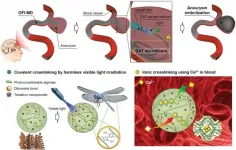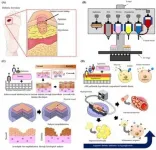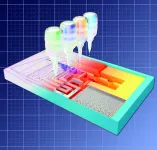(Press-News.org) Cerebral aneurysms are malformations caused by abnormalities on the walls of blood vessels in the brain. When these blood vessels rupture, about 30% of the sufferers die on the spot, giving these the rightful label of 'ticking bombs in the head'. Recently, a research team at POSTECH has come up with a new treatment that can disassemble these time bombs by filling the aneurysm in blood with a new method.
In order to overcome the shortcomings of coil embolization, POSTECH's joint research team (Professor Joonwon Kim and Dr. Jongkyeong Lim of the Department of Mechanical Engineering with Professor Hyung Joon Cha and Ph.D. candidate Geunho Choi of the Department of Chemical Engineering) has developed a new structurally stable, biocompatible embolization material that does not decompose in the human body. In addition, a new concept of cerebral aneurysm therapy (treatment device) capable of stably forming and controlling the material in the form of microfibers in the intravascular environment was presented. These research findings were published as the outside back cover paper of Advanced Materials on April 8, 2021.
Early detection of cerebral aneurysms is increasing due to periodic health examinations. The current treatment method uses coil embolization, which lowers the direction and pressure of internal blood flow by filling the aneurysm with a platinum coil before it ruptures. However, coil embolization surgery is a financial burden since it requires many platinum coils (KRW 600,000 (USD 550) per coil) commensurate to the aneurysm size. Moreover, due to the coil's fine spring structure, the aneurysm may burst during surgery or the inside of the aneurysm may not be completely filled. There are also other problems in which the coil may be detached from the affected area due to recompression caused by the low filling rate after operation.
Hydrogels, which respond to various stimuli such as temperature, pH, and light, and exhibit soft mechanical strength, have attracted great attention as an embolic material that can fill an aneurysm at a high rate. Among them, photocrosslinkable hydrogels are considered to be most suitable for embolization thanks to their easy spatiotemporal control. But their practical usage is limited. In addition, materials being developed for aneurysm embolization currently use high concentrations of biologically inactive synthetic hydrogels that are toxic and not biocompatible. These can also cause severe swelling in the body - often leading to ruptures - and have thwarted their commercialization. In addition, conventional surgical methods could not be applied to clinical applications because it was impossible to produce and control hydrogels using light in an intravascular environment, which has a tortuous geometric structure and high absorbance.
The research team led by Professor Hyung Joon Cha of the Department of Chemical Engineering proposed an alginate-based hydrogel derived from algae that can be double-crosslinked as a new material for aneurysm embolization. This new embolic material exhibits excellent biocompatibility and uses the synergistic effect of rapid covalent crosslinking by irradiation with the harmless visible light and ionic crosslinking using calcium ions present in the blood. In addition, since no degrading enzymes exist in the human body, it does not degrade and exhibits outstanding structural stability without swelling. This can safely and effectively fill the aneurysm and successfully prevent rupture. Since it is possible to mount a contrast medium, it exhibits radiopacity so that the embolic material applied through CT or MRI can be monitored continuously for a long time.
The research team led by Professor Joonwon Kim of the Department of Mechanical Engineering developed a microfluidic device with an integrated optical fiber. This device is a new concept surgical device that can stably produce and control photocrosslinkable hydrogels in the form of microfibers in an extreme intravascular environment, which has a tortuous geometric structure and high absorbance.
Double-crosslinked alginate-based hydrogel microfibers produced and controlled in these microfluidic devices can safely and evenly fill the aneurysms. During this stage, the microfibers intertwine with each other to form a lump to block the flow of fluid from entering the aneurysm and maintain the structural shape and constant mechanical strength without dissociation even in the pulsating environment after surgery. This minimizes a resurge of the pressure inside the aneurysm or its rupture.
"This research is the first in the world to develop a new material for embolization that may be biocompatible without side effects and be stably maintained in the human body for a long time," remarked Professor Hyung Joon Cha. "We plan to deliberate on commercialization through a technology transfer."
Professor Joonwon Kim explained, "This research is the first in the world to develop a method that can be used to treat aneurysms by microfibrillating a photocrosslinkable hydrogel microfiber in blood vessels." He added, "It is anticipated these materials will be effectively applicable to many vascular diseases requiring embolization."
"The new concept of embolization method developed in this study was verified using the Advanced Dynamic Angio Model (ADAM) simulator implemented by the new deep coating technology and 3D vascular replica production technology using liquid embolic materials previously developed by the research team. The ADAM simulator is a system that provides a virtual environment that is very similar to the surgical environment of a real patient, and can be used for simulation of various vascular diseases," explained Professor Kim.
INFORMATION:
This research was conducted with the support from the research-centered hospital nurturing R&D project supported by the Ministry of Health and Welfare and the Korea Health Industry Development Institute, and the Mid-career Research Program and the Nano-New Materials Core Technology Development Program funded by the Ministry of Science and ICT and the National Research Foundation of Korea.
The skin, which covers the surface of the human body, is its largest organ. It is the first organ to show changes stemming from organ or physiological activity. It is especially common for diabetic patients to suffer from skin diseases or infections. Recently, a POSTECH research team has succeeded in creating a 3D artificial skin that enables observation of skin diseases of diabetic patients.
A research team led by Professor Dong-Woo Cho and Minjun Ahn of POSTECH's Department of Mechanical Engineering and Professor Byoung Soo Kim of School of Biomedical Convergence Engineering at Pusan National University has ...
A decade already passed from the first use of bioresorbable vascular scaffold in percutaneous coronary interventions. The first studies - by using surrogate endpoints - showed some superiority of BRS vs. metallic drug-eluting stent in terms of the so-called vascular restoration therapy with recovery of vasomotion and vascular pulsatility when the scaffold was absorbed.
Nevertheless, after these first promising findings, larger and randomized clinical trials and subsequent meta-analyses, powered to hard clinical endpoints, showed that bioresorbable vascular scaffolds, made ...
Researchers at KU Leuven (Belgium) have developed a 3D printing technique that extends the possibilities of lateral flow testing. These tests are widespread in the form of the classic pregnancy test and the COVID-19 self-tests. With the new printing technique, advanced diagnostic tests can be produced that are quick, cheap, and easy to use.
The COVID-19 pandemic has made everyone aware of the importance of rapid diagnosis. The sale of self-tests in pharmacies has been permitted in Belgium since the end of March. This self-test is a so-called lateral flow test. Using a ...
Analysis of The Autopsy, Toxicological, and Psychiatric Reports of Portugal's First Major Forensic Case: Part III
https://doi.org/10.1080/20961790.2021.1898079
Announcing a new article publication for Forensic Sciences Research journal. In this review article the author Ricardo Jorge Dinis-Oliveira of the University Institute of Health Sciences (IUCS)-CESPU, Gandra, Portugal continues a three-part investigation of the "Crime of Flores Street" one of the most famous cases of poisoning which occurred in Portugal in the late 19th century. The case demonstrated the weaknesses of the Portuguese medicolegal system and attests to the importance of toxicological analysis. The first article ...
Most people who are infected with SARS-CoV-2 develop no or only mild symptoms. However, some patients suffer severe life-threatening cases of COVID-19 and require intensive medical care and a ventilator to help them breathe. Many of these patients eventually succumb to the disease or suffer significant long-term health consequences. To identify and treat these patients at an early stage, a kind of "measuring stick" is needed - predictive biomarkers that can recognize those who are at risk of developing severe COVID-19.
First biomarker to predict severity of disease
A team led by Professor Burkhard Becher at the Institute of Experimental Immunology at the University of Zurich, working with researchers from Tübingen, Toulouse and Nantes, has now discovered such ...
Due to the chaotic nature of the atmosphere, weather forecasts, even with ever improving numerical weather prediction models, eventually lose all skill. Meteorologists have a strong desire to better understand this process as they try to trace forecast error back to observational gaps and to provide a means for improvement.
Root mean square error (rms, or its square, the variance distance) is often used to measure differences between simulated and observed fields. In this case, scientists measured the distance between a model forecast field within its grid and the verifying analysis field ...
A pioneering study by UCL scientists has discovered the presence of a harmful inflammatory protein in patients with symptomatic tuberculosis (TB).
Researchers say, by targeting the IL-17 cytokine, a component produced naturally by the immune system in response to infection, excessive and damaging lung inflammation caused by TB may be significantly reduced to help speed up patient recovery.
TB is an infection caused by the bacterium Mycobacterium tuberculosis and is the leading cause of death from infections worldwide. The World Health Organisation estimates that 1.4 million people died of TB disease worldwide in 2019.
Explaining the experimental study, lead author Dr Gabriele Pollara (UCL Division of Infection & Immunity), ...
In a time of a global crisis such as the ongoing COVID-19 pandemic, it is easy to note how people move through different phases to buckle up for such unprecedented and arduous times.
In the very beginning of the pandemic last year, we observed "an epidemic of fear", where it was all about the calamitous nature of a totally unknown virus and its worrying contagiousness and mortality rate. A few months later, with lockdown and restrictions already in place across the world, the fear was replaced by "an epidemic of explanations", where people even in their naivety, started to seek a sense of comfort by ...
Climate change, a pandemic or the coordinated activity of neurons in the brain: In all of these examples, a transition takes place at a certain point from the base state to a new state. Researchers at the Technical University of Munich (TUM) have discovered a universal mathematical structure at these so-called tipping points. It creates the basis for a better understanding of the behavior of networked systems.
It is an essential question for scientists in every field: How can we predict and influence changes in a networked system? "In biology, one example is the modelling of coordinated neuron activity," says Christian Kühn, professor of multiscale and stochastic dynamics ...
Can expert commissions develop solutions for controversial issues that will enjoy broad democratic support? A team of researchers from the Institute for Advanced Sustainability Studies (IASS) has analysed the work of Germany's "Coal Exit Commission" using a set of new criteria. While the authors view positively the Commission's success in reaching a compromise, they criticise its failure to deliver an outcome that promotes the common good, particularly with respect to the high cost of the coal exit and its unambitious contribution towards Germany's climate goals, as well as the lack of public participation.
On 29 April 2021, Germany's Federal Constitutional Court ruled that the provisions of the Climate Protection Act (2019) are incompatible ...




